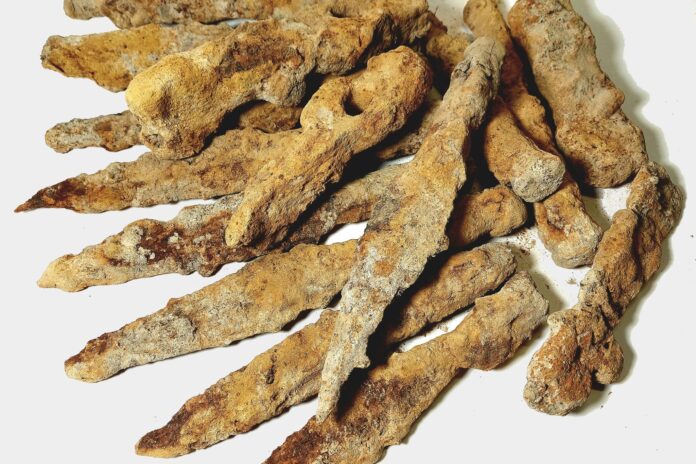A treasure hunter has uncovered a hoard of ancient weapons that were likely used by barbarian tribes during Roman times.
The “accidental discovery” was made in a forested area near the town of Hrubieszów in southeastern Poland, the Lublin Provincial Conservator of Monuments announced in a Facebook post.
The hoard includes several iron artifacts, including nine spearheads, two battle axes and a carpenter’s axe as well as three objects that have yet to be identified.
The treasure hunter, Mateusz Filipowicz, found all of the items hidden in roughly the same place—in a swampy area.
Lubelski Wojewódzki Konserwator Zabytków
“At first, due to the very strong corrosion covering the metal, additionally mixed with sand and mud, it was difficult to determine what these objects were,” the Facebook post said.
“These circumstances led to the discovery of initially one object on the surface, and another one a moment later. Several kilograms of shapeless, muddy, corroded iron were safely packed and taken from the forest with the intention of cleaning and determining the nature of the find,” the post said. “It quickly turned out to be undoubtedly an archaeological find.”

The finds were sent to the Stanisław Staszic Museum in Hrubieszów, where archaeologists conducted a preliminary analysis of the artifacts. The preliminary hypothesis indicates that the weapons were most likely used by barbarian tribes during the time of the Roman Empire.
These warriors may have belonged to the Przeworsk culture, which dates from the 3rd century B.C. to the 5th century A.D., or the Goths—a Germanic people who played a significant role in the fall of the Western Roman Empire.
The number of artifacts found, their nature, the method of deposition and state of preservation indicate that they were not part of a single burial or cemetery in this location. No bones or fragments of pottery were found at the site during a field investigation, which would be expected in a burial pit.
Instead, the evidence suggests that someone deliberately collected these items, packed them in a bag or other container—no trace of which remains—and then dumped them in the swamp.
Log into Facebook to start sharing and connecting with your friends, family, and people you know.
The artifacts are now being kept at the museum, which is taking steps to preserve them.
“Only after these procedures will it be possible to properly determine the nature of the discovery in question and its chronological and cultural affiliation,” the Facebook post said.
Researchers plan to re-visit the location where the artifacts were found in the spring with more favorable weather conditions in the hope of uncovering more information about this discovery.
Do you have a tip on a science story that Newsweek should be covering? Do you have a question about archaeology? Let us know via [email protected].
Uncommon Knowledge
Newsweek is committed to challenging conventional wisdom and finding connections in the search for common ground.
Newsweek is committed to challenging conventional wisdom and finding connections in the search for common ground.


